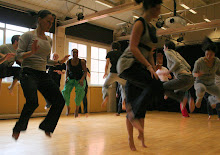‘At its simplest, physical-theatre is theatre where the primary ,means of creation occurs through the body rather than through the mind. In other words, the somatic impulse is privileged over the cerebral in the making process.’
Physical Theatre focuses on using the body as a determiner of movement rather than the mind. This being the imperative tool of Physical Theatre, ensures that provoking emotions, feelings and impulse will be at the heart of its process. Which in it’s self will mean that the performance offers truth to its audience and to its creators. Unlike other forms of Theatre that are restricted by text, stage, a director, time and in some cases the set design, Physical Theatre and it’s process offers the discovery of self or a discovery of an inviduals extended self through play. It requires experience from all aspects of life to bring together a collective piece made by the artists themselves, the performers. It is through this notion of play and personal baggage, that the artists develop their extended selves rather than a character, thus, creating an art form through the body. Lecoq states, ‘the body knows things about which the mind is ignorant’ The development of a self has a canon effect to the process and result of the piece which is why it is imperative that individuals don’t produce characters. Characters stifle and restrict the development of self and a performance, as they cannot add anything more than what they have been assigned to within a piece.
‘The term itself – ‘physical theatre’ – denotes a hybrid character and is testimony to its double legacy in both avant-garde theatre and dance. It is precisely this double current of influences which needs to be taken into consideration in any attempt to delineate specific parameters of the new genre.’ (Sanchez-Colberg in Keefe & Murray; 2007, p 21)
Colberg explains that in order to achieve understanding of the term Physical Theatre, individuals must appreciate that it is a combination of two elements, dance and theatre that moves beyond norms questioning status quo.It is the collaboration of these two forms that bring Physical Theatre to birth. Physical Theatre is a Hybrid character, as it sits in between the two art forms mentioned neither being totally compliant to one or the other. It is this grey area between the two that drives critics and lovers of the art to find an answer, Callery supports this by explaining, ‘Physical Theatre is not codifiable. The term is applied to such a diverse range of work that it has become virtually undefinable. ’ In light of this although there is yet to be a definite definition, it is key to understand that the concept is like no other, there is a demand on the actor to become a creator rather than a visual tool that meaning is given too.
Jasmin Vardimon Company would be classed a perfect example of Physical Theatre as it over steps the boundaries of theatre it self. It aims to provoke and challenge audiences through the use of people and their experiences. More recently in an informal post discussion one of the members (seen below) from the group explained that Jasmin has a ‘love for people’ and the company itself aims to be ‘for the people about the people’ when asked to sum up the way in which the production works.
There website supports this by stating that,
‘Renowned for her uniquely theatrical choreographic and directorial style combining physical theatre, quirky characterisation, innovative technologies, text and dance, Vardimon accentuates her work with an acute observation of human behaviour’
It is clear to assume that the technique used in Process and Performance are ones that are closely followed within this company especially in regards to people and the impact they will indefinitely have on a performance. Like most Physical Theatre companies they too create performance first and then apply the theory behind it for example in their production Yesterday a scene shows all members moving in unison erratically to several spaces within the stage, the movement was developed first and then the idea of a flag controlling them was given afterwards. Therefore supporting that meaning is created through the body rather than adhering to rules or aesthetic ideologies.
Bibliography
• Callery Dymphna, ‘Through the Body’ A Practical Guide to Physical Theatre Routledge 2001 p4
• Keefe, J&S Murray ‘Physical Theatres A Critical Reader’ London:Routledge 2007 p21
• Lecoq Jaques, ‘The Moving Body’ London: Methuen 2000 p9
• www.jasminvardimon.com
Antoinette McCook
skip to main |
skip to sidebar
Welcome to Porto2009.
This is the begining of our journey on the road of Porto2009. And the blog will give us the opportunity as a group to reflect on the work in which we have done within the sessions. We will keep you posted regarding the process we are making along the way.....
Enjoy.
Enjoy.



No comments:
Post a Comment